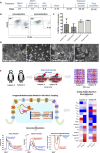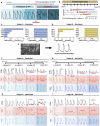Predicting individual-specific cardiotoxicity responses induced by tyrosine kinase inhibitors
- PMID: 37101545
- PMCID: PMC10123273
- DOI: 10.3389/fphar.2023.1158222
Predicting individual-specific cardiotoxicity responses induced by tyrosine kinase inhibitors
Abstract
Introduction: Tyrosine kinase inhibitor drugs (TKIs) are highly effective cancer drugs, yet many TKIs are associated with various forms of cardiotoxicity. The mechanisms underlying these drug-induced adverse events remain poorly understood. We studied mechanisms of TKI-induced cardiotoxicity by integrating several complementary approaches, including comprehensive transcriptomics, mechanistic mathematical modeling, and physiological assays in cultured human cardiac myocytes. Methods: Induced pluripotent stem cells (iPSCs) from two healthy donors were differentiated into cardiac myocytes (iPSC-CMs), and cells were treated with a panel of 26 FDA-approved TKIs. Drug-induced changes in gene expression were quantified using mRNA-seq, changes in gene expression were integrated into a mechanistic mathematical model of electrophysiology and contraction, and simulation results were used to predict physiological outcomes. Results: Experimental recordings of action potentials, intracellular calcium, and contraction in iPSC-CMs demonstrated that modeling predictions were accurate, with 81% of modeling predictions across the two cell lines confirmed experimentally. Surprisingly, simulations of how TKI-treated iPSC-CMs would respond to an additional arrhythmogenic insult, namely, hypokalemia, predicted dramatic differences between cell lines in how drugs affected arrhythmia susceptibility, and these predictions were confirmed experimentally. Computational analysis revealed that differences between cell lines in the upregulation or downregulation of particular ion channels could explain how TKI-treated cells responded differently to hypokalemia. Discussion: Overall, the study identifies transcriptional mechanisms underlying cardiotoxicity caused by TKIs, and illustrates a novel approach for integrating transcriptomics with mechanistic mathematical models to generate experimentally testable, individual-specific predictions of adverse event risk.
Keywords: IPSC-CM cardiomyocytes; cardiotoxicity; kinase inhibitor; mRNA sequencing; mRNASeq; mathematical model.
Copyright © 2023 Shim, Xiong, Dhanan, Dariolli, Azeloglu, Hu, Jayaraman, Schaniel, Birtwistle, Iyengar, Dubois and Sobie.
Conflict of interest statement
The authors declare that the research was conducted in the absence of any commercial or financial relationships that could be construed as a potential conflict of interest.
Figures






Similar articles
-
Functional and Transcriptional Characterization of Histone Deacetylase Inhibitor-Mediated Cardiac Adverse Effects in Human Induced Pluripotent Stem Cell-Derived Cardiomyocytes.Stem Cells Transl Med. 2016 May;5(5):602-12. doi: 10.5966/sctm.2015-0279. Epub 2016 Mar 31. Stem Cells Transl Med. 2016. PMID: 27034410 Free PMC article.
-
Mechanistic Systems Modeling to Improve Understanding and Prediction of Cardiotoxicity Caused by Targeted Cancer Therapeutics.Front Physiol. 2017 Sep 8;8:651. doi: 10.3389/fphys.2017.00651. eCollection 2017. Front Physiol. 2017. PMID: 28951721 Free PMC article.
-
High-throughput screening of tyrosine kinase inhibitor cardiotoxicity with human induced pluripotent stem cells.Sci Transl Med. 2017 Feb 15;9(377):eaaf2584. doi: 10.1126/scitranslmed.aaf2584. Sci Transl Med. 2017. PMID: 28202772 Free PMC article.
-
Moving beyond the comprehensive in vitro proarrhythmia assay: Use of human-induced pluripotent stem cell-derived cardiomyocytes to assess contractile effects associated with drug-induced structural cardiotoxicity.J Appl Toxicol. 2018 Sep;38(9):1166-1176. doi: 10.1002/jat.3611. Epub 2018 Feb 27. J Appl Toxicol. 2018. PMID: 29484688 Review.
-
Chronic Cardiotoxicity Assays Using Human Induced Pluripotent Stem Cell-Derived Cardiomyocytes (hiPSC-CMs).Int J Mol Sci. 2022 Mar 16;23(6):3199. doi: 10.3390/ijms23063199. Int J Mol Sci. 2022. PMID: 35328619 Free PMC article. Review.
Cited by
-
Informing Hazard Identification and Risk Characterization of Environmental Chemicals by Combining Transcriptomic and Functional Data from Human-Induced Pluripotent Stem-Cell-Derived Cardiomyocytes.Chem Res Toxicol. 2024 Aug 19;37(8):1428-1444. doi: 10.1021/acs.chemrestox.4c00193. Epub 2024 Jul 24. Chem Res Toxicol. 2024. PMID: 39046974 Free PMC article.
-
From transcriptomics to digital twins of organ function.Front Cell Dev Biol. 2024 Jun 26;12:1240384. doi: 10.3389/fcell.2024.1240384. eCollection 2024. Front Cell Dev Biol. 2024. PMID: 38989060 Free PMC article.
-
Neural network emulation of the human ventricular cardiomyocyte action potential: a tool for more efficient computation in pharmacological studies.bioRxiv [Preprint]. 2023 Dec 25:2023.08.16.553497. doi: 10.1101/2023.08.16.553497. bioRxiv. 2023. Update in: Elife. 2024 Apr 10;12:RP91911. doi: 10.7554/eLife.91911. PMID: 38234850 Free PMC article. Updated. Preprint.
-
Neural network emulation of the human ventricular cardiomyocyte action potential for more efficient computations in pharmacological studies.Elife. 2024 Apr 10;12:RP91911. doi: 10.7554/eLife.91911. Elife. 2024. PMID: 38598284 Free PMC article.
-
Combining mechanistic modeling with machine learning as a strategy to predict inflammatory bowel disease clinical scores.Front Pharmacol. 2025 Feb 25;16:1479666. doi: 10.3389/fphar.2025.1479666. eCollection 2025. Front Pharmacol. 2025. PMID: 40070575 Free PMC article.
References
-
- Charwat V., Charrez B., Siemons B. A., Finsberg H., Jaeger K. H., Edwards A. G., et al. (2022). Validating the arrhythmogenic potential of high-intermediate-and low-risk drugs in a human-induced pluripotent stem cell-derived cardiac microphysiological system. ACS Pharmacol. Transl. Sci. 5, 652–667. 10.1021/acsptsci.2c00088 - DOI - PMC - PubMed
LinkOut - more resources
Full Text Sources
Molecular Biology Databases

